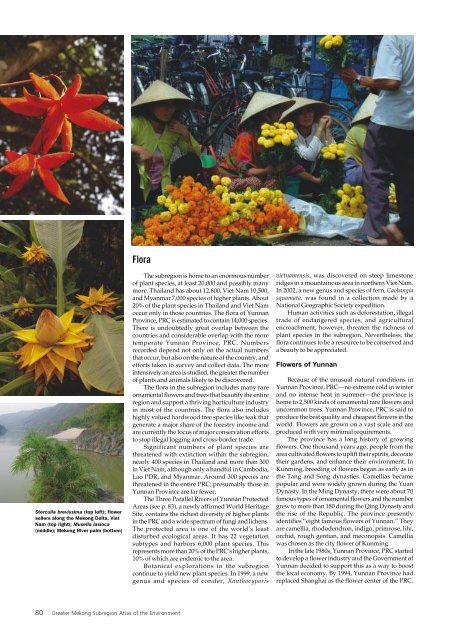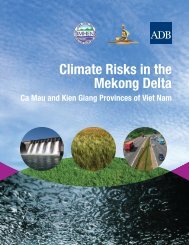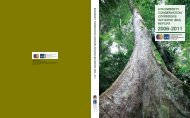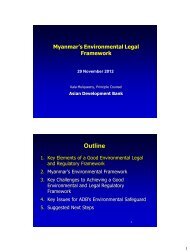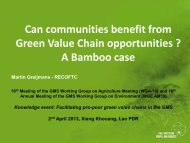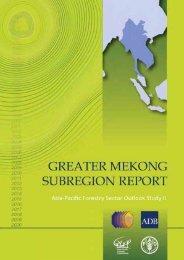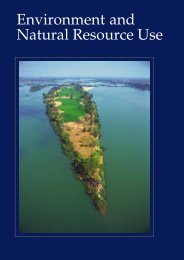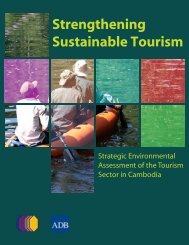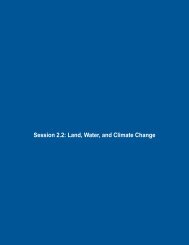Sterculla brevissima (top left); flowersellers along the Mekong Delta, VietNam (top right); Musella lasioca(middle); Mekong River palm (bottom)FloraThe subregion is home to an enormous numberof plant species, at least 20,000 and possibly manymore. Thailand has about 12,600, Viet Nam 10,500,and Myanmar 7,000 species of higher plants. About20% of the plant species in Thailand and Viet Namoccur only in those countries. The flora of YunnanProvince, PRC is estimated to contain 14,000 species.There is undoubtedly great overlap between thecountries and considerable overlap with the moretemperate Yunnan Province, PRC. Numbersrecorded depend not only on the actual numbersthat occur, but also on the nature of the country, andefforts taken to survey and collect data. The moreintensively an area is studied, the greater the numberof plants and animals likely to be discovered.The flora in the subregion includes many rareornamental flowers and trees that beautify the entireregion and support a thriving horticulture industryin most of the countries. The flora also includeshighly valued hardwood tree species like teak thatgenerate a major share of the forestry income andare currently the focus of major conservation effortsto stop illegal logging and cross-border trade.Significant numbers of plant species arethreatened with extinction within the subregion,nearly 400 species in Thailand and more than 300in Viet Nam, although only a handful in Cambodia,Lao PDR, and Myanmar. Around 300 species arethreatened in the entire PRC; presumably those inYunnan Province are far fewer.The Three Parallel Rivers of Yunnan ProtectedAreas (see p. 83), a newly affirmed World HeritageSite, contains the richest diversity of higher plantsin the PRC and a wide spectrum of fungi and lichens.The protected area is one of the world’s leastdisturbed ecological areas. It has 22 vegetationsubtypes and harbors 6,000 plant species. Thisrepresents more than 20% of the PRC’s higher plants,10% of which are endemic to the area.Botanical explorations in the subregioncontinue to yield new plant species. In 1999, a newgenus and species of conifer, Xanthocyparisvietnamensis, was discovered on steep limestoneridges in a mountainous area in northern Viet Nam.In 2002, a new genus and species of fern, Caobangiasquamata, was found in a collection made by aNational Geographic Society expedition.Human activities such as deforestation, illegaltrade of endangered species, and agriculturalencroachment, however, threaten the richness ofplant species in the subregion. Nevertheless, theflora continues to be a resource to be conserved anda beauty to be appreciated.Flowers of YunnanBecause of the unusual natural conditions inYunnan Province, PRC—no extreme cold in winterand no intense heat in summer—the province ishome to 2,500 kinds of ornamental rare flowers anduncommon trees. Yunnan Province, PRC is said toproduce the best quality and cheapest flowers in theworld. Flowers are grown on a vast scale and areproduced with very minimal requirements.The province has a long history of growingflowers. One thousand years ago, people from thearea cultivated flowers to uplift their spirits, decoratetheir gardens, and enhance their environment. InKunming, breeding of flowers began as early as inthe Tang and Song dynasties. Camellias becamepopular and were widely grown during the YuanDynasty. In the Ming Dynasty, there were about 70famous types of ornamental flowers and the numbergrew to more than 180 during the Qing Dynasty andthe rise of the Republic. The province presentlyidentifies “eight famous flowers of Yunnan.” Theyare camellia, rhododendron, indigo, primrose, lily,orchid, rough gentian, and meconopsis. Camelliawas chosen as the city flower of Kunming.In the late 1980s, Yunnan Province, PRC startedto develop a flower industry and the Government ofYunnan decided to support this as a way to boostthe local economy. By 1994, Yunnan Province hadreplaced Shanghai as the flower center of the PRC.80 Greater Mekong Subregion Atlas of the Environment
The province now contributes more than 50% of thetotal sales volume of cut flowers in the PRC. Theindustry produces around 1.1 billion stems eachyear, worth about $57 million. In 2000, YunnanProvince, PRC grew flowers on total land area of2,000 hectares, mostly in Kunming, Jinghong, andZhongdian. More than 100 million seed plants arealso sold annually.Aside from the domestic market, YunnanProvince, PRC also exports flowers, mainly to Japan;Republic of Korea; Hong Kong, China; Thailand;and Singapore. Export earnings in 1999 amountedto $5.28 million.The success of the flower industry in YunnanProvince, PRC can be attributed to the initiatives offarmers in the village of Dounan in the late1980s.They used to grow vegetables for their livinguntil a farmer in the village, during his trip toGuangzhou, found that there was a high demandfor flowers in the cities. At the same time, there wasa decrease in prices of vegetables because ofoversupply. He planted some gladiolis in his landand other farmers in the village soon followed hisexample. The flower cultivation area expandedquickly and in less than half a decade, Dounan hadbecome one of the major production and wholesalecenters for cut flowers in the PRC.Orchids of ThailandThailand is well known for its many beautifulorchids, locally known as “Gluay Mai.” There arearound 1,300 species of orchids in the country. Theycome in many gorgeous colors and shapes and varyfrom common to rare. Although they are most prolificin the north, orchids are found in all parts ofThailand, from the low plains of the central regionto the highest mountains of the north, from the forestsof the south to the dry northeastern plateau.The most beautiful of Thailand’s orchids are thewhite, the bright yellow oncidium, and the brick redorchids. The white orchid commands a high pricebecause of its scarcity in the wild. Other orchidvarieties are easy to grow and are abundant yearround, such as the violet bloom, which is usuallyoffered to visitors. There are many orchid farms innorthern Thailand; Chiang Mai is considered thecenter for cultivation and exhibition of these exoticflowers.Interest in orchid cultivation in Thailand can betraced back in 1913 when some exotic plants werebrought to the attention of Prince Krompranakornsawanvorapinit.He became interested ingrowing orchids, both as a hobby and for commercialpurposes. In 1957, the Orchid Society of Thailandwas formed under royal patronage.The most important orchid study center in thenorth of Thailand is found in Doi Inthanon NationalPark. This park is an abode to more than 25% of allthe orchid species in Thailand. Orchids are foundin the deciduous forests from the foothills to theforests at the top of the mountain within the park.The most common species is Dendrobiuminfundibulum. Also, many rare montane orchids canbe found along the Keo Mae Pan Nature Trail nearthe summit of the park.Orchid production is an important source ofexport earnings in Thailand. Ninety-five percent ofthe production is for export. Total orchid productionin 1999 was estimated at 25,200 tons, with aproduction value of about $300 million.Vanishing TeakTeak (Tectona grandis (Linn)) is a highly-valuedwood because of its elegance, quality, and highresistance to weathering. Teak trees grow in groupsamong other tropical species and are oily to thetouch. The oil makes the trees extremely durableagainst water, rust, and termites, and the wood canlast for more than a thousand years. Teak plantationsare abundant in the subregion, particularly inMyanmar and Thailand. Myanmar is now one ofthe world’s biggest suppliers of teak. Teakproduction there is the biggest source of forestrysector earnings and provides significant foreignexchange to the country. In 1995, teak exportsreached 200,000 m 3 , with a value of $200 million. Ifmanaged properly, teak production could becomeone of the pillars of Myanmar’s economy in thefuture.Before the Second World War, teak was the thirdmost important export commodity of Myanmar. Inthe early 1970s, teak exports accounted for 25% oftotal export earnings. With the decline in rice exports,Myanmar identified the forestry sector as a primarysource of foreign exchange to boost the economy.Increased investment led to an increase in annualteak production from 291,000 tons in 1971 to 440,000tons in 1991. A major cause for the increase was theban by Thailand in 1989 on cutting timber from itsforests. To ensure supplies of wood, Thailand signeda series of logging contracts with Myanmar. Theincreased rate of timber extraction in Myanmarcaused growing concern about Myanmar’s forestresources. At 1990 felling rates, it was estimated thatthe teak stock would be depleted within 15 years.Because of the unsustainable cutting of teak,Myanmar has now focused its forest managementon the sustainable management of natural teakbearingforests. The annual allowable felling of teaktrees was lowered from 609,000 to 409,060 m 3 .Myanmar has also programmed the planting of treeson 40,500 ha per year, of which teak plantationscover 8,100 ha, on a 40-year rotation. The countryhas also established two model forests in whichnatural teak forests are prominent, namely Oktwinand Pauk Khaung model forests in Bago YomaRegion.Myanmar is the headquarters of the Asia-Pacificregional network TEAKNET, the objective of whichis “to strengthen interaction among all thoseconcerned with the conservation and sustainablemanagement of teak-bearing forests and plantationsthrough sharing of information and promotingcollaborative efforts to deal with common problems.”Thailand orchids (upper); teak trees inMyanmar (lower)Hedychium flavescensEnvironment and Natural Resource Use 81


